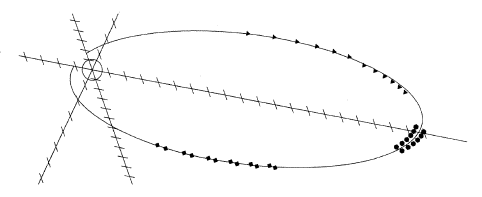Systematic Identification of Preferred Orbits for Magnetospheric Missions: 2. The "Profile" Constellation
Laboratory for Extraterrestrial Physics, Goddard Space Flight Center, Greenbelt, MD 20771.

|
Abstract Using orbital criteria developed in part 1 of this study (Stern, [1]), a "Profile" constellation mission is developed for studying the Earth's magnetosphere. The basic "Profile" has 6 satellites in each of two close orbits with apogee 25 RE or 20 RE, (Earth radii, 1 RE = 6371 km), but it can be extended to a "Twin Profile" mission with two coplanar constellations (total of 24 s/c), covering the magnetosphere end-to-end and requiring only one launch. One constellation of 12 then has apogee at midnight (or at other times, dusk), the other at noon (or dawn), and the two exchange positions every 6 months. The small satellites (17 kg, 29 w) will measure magnetic fields, ion and electron energy spectra, and plasma bulk flows. They require a minimal Δv and can therefore be flung off in pairs from a spinning mother ship, assuring a scientifically desirable spin axis and other benefits. Simulation codes derive the week-by-week coverage of 10 magnetospheric regions by the 12 satellites, as well as the annual number of hours certain formations occur, e.g. 9+ satellites within 2 RE of the tail's neutral sheet. Of particular interest is the tight clustering of 6 to 12 satellites at r > 23E (for 25 RE apogee), enhancing (at various times) local coverage of the substorm reconnection region, low latitude boundary layer and bow shock. The article concludes with a list of 30 targeted scientific investigation, each with its appropriate formation. |
The author may be reached at david("at" symbol)phy6.org.
Last updated 31 October 2002
